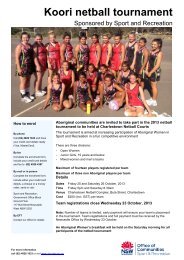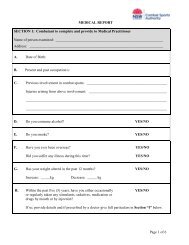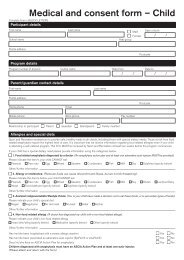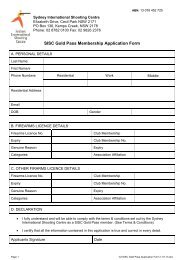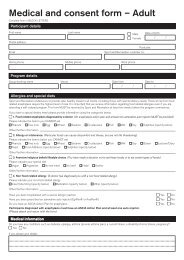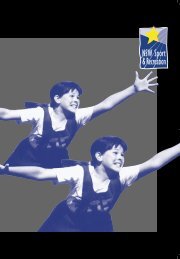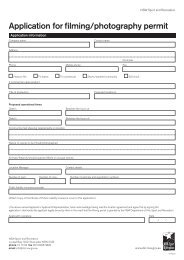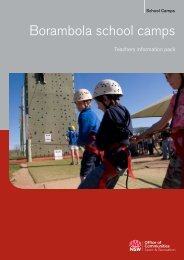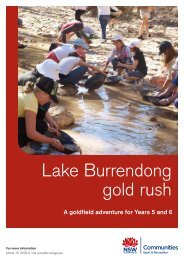Facts on Walking - NSW Sport and Recreation
Facts on Walking - NSW Sport and Recreation
Facts on Walking - NSW Sport and Recreation
You also want an ePaper? Increase the reach of your titles
YUMPU automatically turns print PDFs into web optimized ePapers that Google loves.
<strong>NSW</strong> Department of <strong>Sport</strong> <strong>and</strong> Recreati<strong>on</strong>Active Community Guide<str<strong>on</strong>g>Facts</str<strong>on</strong>g> <strong>on</strong><strong>Walking</strong>13 13 02www.dsr.nsw.gov.au
An active way of life is important for all of us <strong>and</strong>becomes more important as we grow older. <strong>Walking</strong> ata comfortable speed improves heart-lung functi<strong>on</strong>. It isalso good for general fitness as well as being safe, cheap<strong>and</strong> c<strong>on</strong>venient. It can be enjoyed al<strong>on</strong>e or with friends.<strong>Walking</strong> is good for youIf you walk regularly you tend to:• Feel more c<strong>on</strong>fident, happy <strong>and</strong> relaxed• C<strong>on</strong>trol your weight better• Have a healthier blood cholesterol level• Have lower blood pressure• Have str<strong>on</strong>ger b<strong>on</strong>es (less osteoporosis)• Be less likely to have a heart attack• Recover better from a heart attack• Be less likely to have a stroke• Be less likely to develop diabetes in middle age.How often Try to walk everyday. Ideally, adults shouldget a total of 30 minutes or more of moderate exercise — likewalking — <strong>on</strong> most (preferably all) days of the week. The moreexercise you can do the better — providing you follow the stepsoutlined here.How hard Find the level that suits you best. You shouldstill be able to talk (or whistle) comfortably as you walk.
Getting started<strong>Walking</strong> is a great social activity. You can walk with a friend,join a club or you may prefer to walk al<strong>on</strong>e. Whatever youdo, the aim is for comfort <strong>and</strong> enjoyment while keeping active.Before getting started, see your doctor if you:• Have not been active for some time• Have a history of heart disease or chest pains• Have diabetes• Are very overweight• Are a smoker• Have high blood pressure.Staying motivated• Walk with a friend, in a group or with your spouse <strong>and</strong> family• Use the times you walk to think — <strong>and</strong> relax• Plan your walks in advance• Vary your walks• Visit a nati<strong>on</strong>al park or an historical l<strong>and</strong>mark• Visit a friend• Walk the dog• Join a walking club.
10 important tips1. Wear a broad brimmed hat <strong>and</strong> sunglasses, <strong>and</strong> use a broadspectrum sunscreen SPF15+ <strong>on</strong> exposed skin. Avoidthe hottest times of the day, <strong>and</strong> keep to shaded areas.2. Wear light, loose, comfortable clothing <strong>and</strong> well cushi<strong>on</strong>edflat-soled shoes.3. Always let some<strong>on</strong>e know where you are going <strong>and</strong>your expected time of return.4. Walk steadily, c<strong>on</strong>centrating <strong>on</strong> a steady heel toe acti<strong>on</strong>,letting your arms swing freely by your sides. After a while,you will develop the rhythm <strong>and</strong> stride most natural foryour weight <strong>and</strong> height.5. If you are going <strong>on</strong> a l<strong>on</strong>g or strenuous walk, drink waterbefore you start <strong>and</strong> carry a supply with you, especiallyin hot weather. A small backpack is useful for carryingwater, sunglasses, sunscreen <strong>and</strong> other items.6. If your breathing becomes uncomfortable, slow down,<strong>and</strong> try not to stop completely if you have been walkingbriskly. Sudden halting can cause a feeling of dizziness asoxygenated blood drops with gravity away from the brain.7. In cold weather, a hat prevents heat loss from the head.8. Avoid walking immediately after meals <strong>and</strong> d<strong>on</strong>’t walkif you have a fever or a bad cold.9. If you are walking in the dark, wear light coloured clothingso motorists can easily see you.10. You may feel some soreness in the early stages of yourprogram, as your body adjusts to new dem<strong>and</strong>s beingplaced up<strong>on</strong> it. As your body adapts, the soreness willdecrease. In additi<strong>on</strong>, stretching before <strong>and</strong> after exercisecan help to minimise soreness.
StretchingIt is desirable to stretch both before <strong>and</strong> after you go<strong>on</strong> your walk. Try the stretches below <strong>and</strong> remember youshould always be warm before stretching.• Ease into, hold <strong>and</strong> ease out of each stretch• Hold each stretch for a minimum of 20 sec<strong>on</strong>ds• Stretching should never be painful, although you may feela mild discomfort• Never bounce while stretching• Perform stretches <strong>on</strong> both legs.⌖ Prop leg against a tree or chair at a comfortableheight with knee slightly bent, lean slowly forwardto feel the stretch at the back of the thigh.See picture above right.⌖ St<strong>and</strong> with h<strong>and</strong>s placed <strong>on</strong> wall for support.Put <strong>on</strong>e leg behind keeping heel flat <strong>on</strong> ground.Keep other leg slightly bent with weight <strong>on</strong> backleg. Hold for 20 sec<strong>on</strong>ds. Repeat with other leg.See picture above centre.⌖ Sit <strong>on</strong> chair with both feet <strong>on</strong> floor. Turn arms,head <strong>and</strong> shoulder to grasp the back of the chair.Keep buttocks <strong>on</strong> chair. Hold for 20 sec<strong>on</strong>ds.Repeat <strong>on</strong> other side.⌖ Bring heel to bottom <strong>and</strong> push hip forwardto increase stretch. Hold for 20 sec<strong>on</strong>ds.Repeat <strong>on</strong> other leg. See picture above left.
Sore feetYour most important equipment is a pair of sturdy, comfortablelightweight walking shoes. If your feet feel good, you willwalk well — <strong>and</strong> c<strong>on</strong>tinue walking. When choosing the rightwalking shoes, check for:• Upper of breathable material – leather <strong>and</strong>/or nyl<strong>on</strong> mesh• Comfortable, padded heel collar• Firm heel counter (that cups the heel)• Stability for the entire foot <strong>and</strong> leg• Heel should be held in the shoe, well cushi<strong>on</strong>ed <strong>and</strong>supported somewhat higher than the rest of the foot• Entire shoe should be designed to absorb shock• Substantial arch supports• A sole designed specifically for smooth heel-to-toe moti<strong>on</strong>• The toe box should allow ample room.After a heart attackIf you have recently had a heart attack or heart surgery,exercise will play an important part in your recovery. <strong>Walking</strong>is safe <strong>and</strong> easy <strong>and</strong> you can begin with an easy stroll twicea day during the week after you leave hospital. Use thechart below as your guide to getting into a regular walkingprogram. But talk it over with your doctor first.WEEK MINUTES DISTANCE PER DAY SPEED1 5–10 250m 2 Stroll2 10–15 500m 2 Comfortable3 15–20 1000m 2 Comfortable4 20–25 1500m 1–2 Comfortable/Stride out5 25–30 2000m 1–2 Comfortable/Stride out6 30 2500m 1–2 Comfortable/Stride out
<strong>Walking</strong> For Pleasure<strong>Walking</strong> For Pleasure is a <strong>NSW</strong> Department of <strong>Sport</strong> <strong>and</strong>Recreati<strong>on</strong> program which promotes regular walking witha walking for pleasure club. The groups walk in locati<strong>on</strong>ssuch as nati<strong>on</strong>al parks, places of historical interest <strong>and</strong> beaches.Participating in a <strong>Walking</strong> For Pleasure club is:• Enjoyable• Social• Easy• Accessible• Healthy• FREE to join.<strong>Walking</strong> For Pleasure clubs have been set up all overNew South Wales <strong>and</strong> people participate in regular walks<strong>on</strong> a weekly or fortnightly basis. Most <strong>Walking</strong> For Pleasureclubs start with a meeting of interested people <strong>and</strong> clubsoperate <strong>on</strong> a casual basis, with members deciding where<strong>and</strong> when they want to walk.There’s a <strong>Walking</strong> For Pleasure club near you <strong>and</strong> it’sFREE to join! Ph<strong>on</strong>e 13 13 02.Other useful c<strong>on</strong>tacts:• Bushwalking Clubs of <strong>NSW</strong>• Department of L<strong>and</strong> <strong>and</strong> Water C<strong>on</strong>servati<strong>on</strong>• Nati<strong>on</strong>al Parks <strong>and</strong> Wildlife• Nati<strong>on</strong>al Heart Foundati<strong>on</strong>• <strong>NSW</strong> Department of Health.Also, some councils, leisure centres, neighbourhood <strong>and</strong>community centres may have community walking groupsthat walk in local areas.
Supported byPublished by the <strong>NSW</strong> Department of <strong>Sport</strong> <strong>and</strong> Recreati<strong>on</strong> April 2002



